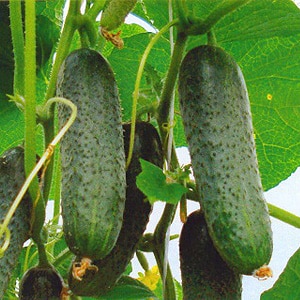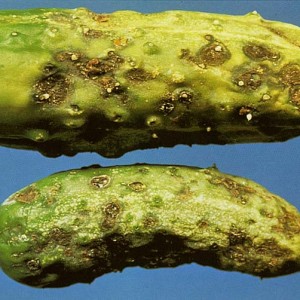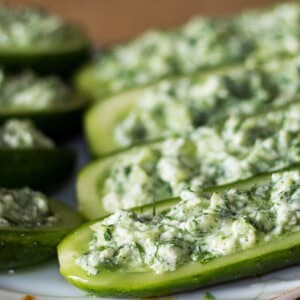How to grow “Courage” cucumbers on your site and why they are good
No garden is complete without a bed of crunchy and prickly cucumbers. Many gardeners prefer to grow hybrids, since the latter are characterized by increased resistance to disease and ease of care. Hybrid Courage is no exception; from year to year it shows stable and high yields. The taste and appetizing appearance were appreciated by all housewives and cooks. Let us consider the description of the Courage variety in detail.
Description of cucumbers
Courage is a hybrid that shows high productivity in any climatic conditions. In cold regions, the vegetable is planted in greenhouses or greenhouses; in regions with temperate and warm climates, it bears fruit well in open ground.
Distinctive features
The vegetable has a developed root system and strong stems. The leaves are large, classic green in color. The harvest ripens within 40-45 days from planting. Summer residents prefer to grow cucumbers in seedlings, which has a positive effect on the number of vegetables harvested.
Properties, benefits, calorie content
 The vegetable consists of 90% water, which removes toxins from the body and cleanses the kidneys. The product contains vitamins B, A and C, fiber, magnesium, iron, phosphorus, calcium.
The vegetable consists of 90% water, which removes toxins from the body and cleanses the kidneys. The product contains vitamins B, A and C, fiber, magnesium, iron, phosphorus, calcium.
Regular consumption of the vegetable cleanses the intestines and has a beneficial effect on the thyroid gland. Fresh cucumbers prevent the occurrence of cholesterol plaques and serve as a prevention of cardiovascular diseases.
Vegetables are indispensable for those who are watching their figure, because 100 g of cucumber contains only 15 kcal.
Important! If you have chronic intestinal diseases, you need to be careful with cucumbers. It is recommended to use them in moderation. It is better to peel the cucumbers before eating.
Characteristics
The hybrid bushes are branched and have many leaves. During the ripening process, the bushes are shaped to get as much harvest as possible. The fruits themselves are medium in size, oval and elongated. The weight of the vegetable is 120-140 g, the surface has small spikes.
The pulp is light green, juicy, there are few seeds. The taste of the hybrid is juicy and fresh. 25-30 cucumbers grow simultaneously on one bush.
How to grow a hybrid yourself
Gardeners grow Courage in two ways: seedlings and seeds. Let's look at each of them and identify the distinctive features of crop care.
Planting seeds in open ground

This method is suitable for gardeners in warm regions with hot summers and fertile soil. Heavy seeds are selected for planting.
It is better to purchase material from trusted manufacturers with a good reputation. In the fall, the beds are prepared in advance.
Suitable predecessors for cucumbers are legumes, onions or cabbage. The earth is dug up to 10-15 cm, cleared of debris and weeds. Add peat or humus to the soil.
In April, the soil is dug up again and ash or sawdust is added. Fertilizers make the soil more nutritious and fertile.
Important! Before planting, the seeds are disinfected with soda. For 1 liter of water there are 10 g of powder. The material is soaked in the resulting solution for 24 hours. A solution of succinic acid also gives an excellent effect. For 1 liter of water you need 15 ml of acid. Processing time 18-25 hours.
The distance between the holes should be at least 50 cm. The seeds are placed in grooves to a depth of 3 cm. 4-5 seeds are placed in each hole and sprinkled with loose soil on top. After 10 days, the seedlings are thinned out, the distance between the sprouts is reduced to 40 cm.
Seating arrangement
In addition to disinfected seeds, seedlings require a suitable container. The plant is planted in wooden boxes, flower pots, plastic cups, and kefir bags. Experienced gardeners purchase special peat capsules. The container is made of environmentally friendly material, easy to use, and inexpensive. Peat tablets take up little space; they are placed on the windowsill in a tray.
The soil for seedlings is also prepared in advance. To do this, use soil from the garden mixed with manure and ash. Before planting, the soil is disinfected with a solution of manganese or aloe juice. The seeds are placed in holes and covered with soil, then watered abundantly with warm water. The optimal temperature for seedlings is 28 degrees Celsius. As soon as the first shoots appear, the temperature is lowered to 18 degrees. Water the seedlings every 5 days.
Growing and care
First of all, follow the watering regime.
Drying out the soil negatively affects the taste of the vegetable, which becomes bitter and watery. Water the beds with warm water, as cold water leads to the formation of gray rot and inhibited growth. To retain moisture, the soil is mulched, that is, straw or fresh mown grass is added to the beds. Before watering, the soil is loosened so that it becomes more nutritious and airy. The loosening depth is no more than 10 cm, so as not to damage the delicate and fragile roots.
The hybrid needs nutritional supplements.Experienced summer residents alternate mineral and organic fertilizers.
During the flowering period, yeast is added to the beds (a pack of yeast is dissolved in 10 liters of water and left to brew for 3 days). Fertilizing stimulates the growth of cucumbers and improves taste.
After 2 weeks, chicken manure is added, which is rich in zinc, potassium, iron, copper and zinc. Use fertilizer 2-3 times per season.
Features of cultivation and possible difficulties
During the growing process, summer residents are faced with the following problem: many large leaves and few fruits. Due to the excessive foliage of the bush, cucumbers do not have enough sunlight, which is why they stop growing and lose their elasticity.
Forming a bush will help correct the situation: remove too large leaves, leaving the petioles. It is necessary to regularly inspect cucumber beds and remove leaf blades that are too large.
Important! Falling off of the ovaries and yellowing of cucumbers - a sign of excess water or fertilizing. Most often this happens with a tight fit. To eliminate the problem, the beds are sprinkled with wood ash. The product removes excess moisture from the soil and reduces acidity.
It is better to water and feed Courage early in the morning or in the evening, after sunset. Otherwise, sunburn will appear on the leaves. Before watering, water is heated in the sun, in large tanks or buckets. It is important to direct water directly to the root, bypassing the leaves and stems, otherwise the risk of developing fungal infections and viral diseases increases.
Diseases and pests
Even the most disease-resistant hybrids get sick from time to time. Cucumber Courage is no exception.
The most common diseases are:
- Powdery mildew appears as a white coating on the leaves. The causes of infection lie in high humidity and improper care. For prevention, spraying with ash solution, Bordeaux mixture, and potash fertilizers is used. If measures are not taken in time, the leaves will dry out and the cucumbers will stop growing. An effective remedy for combating powdery mildew is the drug “HOM”.

- Cladosporiosis - This is brown olive spot. It develops quickly in rainy and cloudy weather. The source of infection can be soil, weeds, seeds. To prevent disease, gardeners water the beds only with warm water and follow the rules of crop rotation. Fundazol or Oxychom products help in the fight against cladosporiosis.
- When infected with gray rot, leaves, stems and fruits become covered with a light gray coating. Bacterial disease occurs due to an excess of minerals and low temperatures. If the disease has just appeared, then the bushes are treated with Rovral. For a more serious fight against gray rot, use Bordeaux mixture or the drug “Bayleton”.
Among the pests, the root-knot nematode will attack cucumber beds. Small worms are difficult to see with the naked eye. The pest damages the roots, causing the entire plant to dry out. Sterilization of the soil and treatment with a solution of copper sulfate help fight the worm.
If not properly cared for, you can find mole crickets, whiteflies, and aphids in the garden beds. To avoid their negative effects, experienced gardeners follow the rules of crop rotation, care for the plant in a timely manner, and fertilize the soil.
Harvesting and application
 Cucumbers are harvested in June. Cleaning is done regularly, without waiting for the fruit to outgrow. Every 2-3 days, summer residents inspect the beds and pick elastic small cucumbers.It is better to pick the fruits in the morning or evening, at which time they become hard.
Cucumbers are harvested in June. Cleaning is done regularly, without waiting for the fruit to outgrow. Every 2-3 days, summer residents inspect the beds and pick elastic small cucumbers.It is better to pick the fruits in the morning or evening, at which time they become hard.
Cucumbers are cut with scissors or pruning shears, but some gardeners also harvest with their bare hands. It is important not to get scratched, because the surface of the hybrid is slightly scratchy. The stalks should remain on the vines. Leaves and stems should not be picked or twisted.
Important! Fresh cucumbers do not last long. It's best to eat them right away or process them. A regular refrigerator helps keep vegetables tasty. The optimal temperature for storage is 6-8 degrees Celsius, air humidity is from 85% to 95%.
Delicious dishes are prepared from cucumbers pickles for the winter, vegetable light salads, sandwiches and snacks. Housewives are experimenting with the product and even prepare cold soups from cucumber.
Interesting! A popular recipe is made with cucumber, mint and yogurt. All ingredients are mixed in a blender and seasoned with salt and pepper. Cold soup fits perfectly into a healthy diet.
For a sweet dish, use cucumber, vanilla and ginger. Makes a great cooling snack.
Advantages and disadvantages of the variety
The Courage hybrid has many advantages: juicy taste, ease of care, high and stable yield. Cucumbers are resistant to diseases and pests and are suitable for growing in any climate zone.
Vegetables are universal in use, good both fresh and after heat treatment. They have a lot of useful vitamins and minerals and form the basis of a proper and healthy diet.
One of the disadvantages is that you need to buy seeds every year. Many summer residents complain about the high cost of seeds of the hybrid Courage f1. Otherwise, the hybrid has no significant disadvantages.
Reviews
Many farmers have already tried to grow Courage cucumbers on their plots.
Lilia, Ufa: «Early ripening cucumbers Kurazh I have been planted for the third year in a row. I like their appearance and crispy taste. Maintenance requires only regular watering and loosening. Twice a season I feed with ash and droppings.”
Maria, St. Petersburg: “I prefer to grow only hybrids. They rarely get sick, which is important for the climate of my region. I am satisfied with the harvest; 2-3 kg are harvested from 1 bush. I recommend for landing."
Elizabeth, Kurgan: “I didn’t like Courage because the bushes need to be shaped. There are a lot of large leaves growing in the garden bed, but the cucumbers themselves are small and difficult to find among the foliage. Compared to other hybrids, Courage seemed to me the most whimsical.”
Read also:
How to deliciously prepare Chinese cucumbers for the winter: recipes and useful tips.
Conclusion
Hybrid Courage is recommended for growing by novice gardeners. Planting and care does not require special knowledge. Cucumbers love organic fertilizers, such as ash or manure.
Before planting, the soil is sterilized and the seeds are soaked in a solution of succinic acid. The bushes should be at a distance of 40-50 cm from each other, no less. Vegetables are picked slightly unripe. Cucumbers are indispensable in cooking, because in addition to taste, they also bring benefits: they cleanse the body of cholesterol and help to lose excess weight.